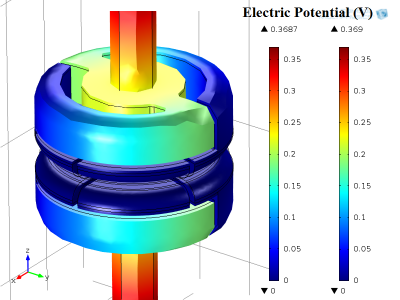
Vacuum circuit breakers (VCBs) are finding increased usage in the medium voltage range (1 - 52 kV) due to their robustness and compactness. As the entire current interruption process takes place inside a closed vacuum enclosure (vacuum bottle), the VCB is maintenance free. Vacuum technology has progressed over the years and VCBs have become increasingly compact. As a result they have developed an edge over SF6 circuit breakers. Presently, VCBs have a comparable market share as that of SF6 breakers in the switchgear sector. In the Computational Electromagnetics Research group, we work on problems of direct relevance to the industry. Presently, we are working on the following problems related to vacuum interrupters (VI):
Effect of eddy currents in axial magnetic field (AMF) type VI
In the AMF type VI, axially oriented magnetic field is applied on the vacuum arc to make it diffuse over the entire contact surface and facilitate current interruption. But the AMF links the contact plates and induces eddy currents in them. Eddy currents cause a phase delay in the AMF with respect to the current, which is detrimental to current interruption. We have analysed the effect of various contact design parameters on the AMF contact performance. The effects of contact opening velocity, radial slots in the contact plate and angular offset in the radial slots have been studied using FEM simulations (Fig. 1).
Computation of Lorentz force on the arc in radial magnetic field (RMF) type VI
The RMF type VI is designed to produce a circumferential force on the vacuum arc, which makes it rotate on the contact surface and minimises contact erosion. For efficient contact design, it is essential to control the direction and magnitude of the force on the arc such that it produces smooth circular motion of the arc. The variation of the force as the arc proceeds along its path has been analysed (Fig. 2). Analytical formulations have been developed to calculate the force as a function of the contact petal parameters.
Prof. S V Kulkarni
